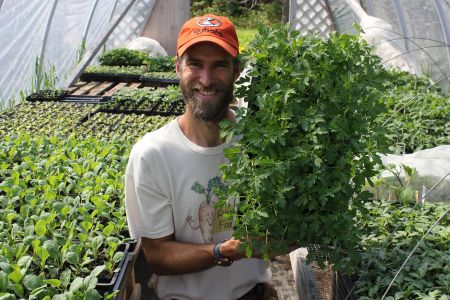How to Start Your Own Seeds
Growing your own seedlings from seed is fun, rewarding and brings hope during the cold, early spring days while we wait for planting time!
Seeing green is food for your soul for sure!
It's true that growing your own seedlings can be tricky. It even happens that some of them die.
And that is sad, but don't let it get you down! It happens to the best of us!
I wrote this blog post to help set you up for success. To help take some of the guesswork out of it and let you know the things that we've learned over the years.
Because, let's face it, we all make mistakes. But, that's how we learn!
So, here's to your success in starting your own seeds!

The most important thing about starting seeds is timing
I can't stress this enough. When starting your own seeds and seedlings, rushing is never the best way.
Yes, it may be tempting to get things going now after a few days in the 60's... I mean, it definitely DID feel almost like summer so much that I had the windows open in our house!
But, believe me, starting seeds too early whether for seedlings or directly in your garden is a sure fire way to get off on the wrong foot.
I'm going to assume that you live in Central Maine or close enough so I'll give you the info that we use to make our decisions. So figure out your average last spring frost date. In Central Maine this is around June 1. (I remember that we got a frost in the first days of June in 2019 and 2020. Did you?)
The average last spring frost date is the date when it’s safe to plant most flowers, veggies and herbs outdoors. If you plant outdoors before this date, you risk losing your plants to a late spring frost like many people did last year. Of course there are some plants that are hardy or frost tolerant that can be planted out before this date. Check your seed packets or check out this list below.
While it seems counter-intuitive, err on the side of sowing seeds a bit later rather than earlier. Starting your seedlings too early is the number one most common reason for stunted, unhappy plants!
Here is what we aim for in Central Maine for the first planting of each of these crops. Many of them like broccoli, cabbage, lettuce, etc. can be seeded throughout the season. More about succession planting here at this blog post.
You are welcome to experiment with your own situation, too!
8 Weeks before Average Last Spring Frost (April 5-ish for us)
- Leeks
- Scallions
- Eggplant
- Pepper (Hot or sweet)
- Onions (you can start these earlier, as the only exception to our 'don't rush it rule'. Actually we get ours from another farmer, Jason Kafka, who has large greenhouses and gets things going earlier than we do. We would start these 12 weeks before last frost, around March 10, if we had a good set up for starting seeds this early.)
6 Weeks before Last Average Spring Frost (April 20-ish for us)
- Herbs (perennial types, like chives, oregano, sage, thyme, etc, and slow growing annual types like basil and parsley)
- Broccoli
- Cabbage
- Kale
4-6 Weeks before Last Average Frost (May 5-ish for us)
- Lettuce
- Pac Choi (Bok Choy)
- Tomatoes
2 Weeks before Average Last Spring Frost (May 20-ish for us)
- Cucumbers
- Melons
- Pumpkins
- Squash
- Sunflowers
- Watermelons
What do you need to get started?
#1 You need the right supplies:
- Seeds: We get ours from several companies that cater towards commercial growers like Johnny's Selected Seeds, High Mowing Organic Seeds, Fedco Seeds, etc. These companies and many others also offer lots of small packet sizes for home gardeners. We look for companies that take the safe seed pledge and don't sell Genetically Modified seed (aka GMO or GE).
- Seed trays or “six packs”: something to grow the seeds in. You can purchase new trays or reuse “six packs” from plants you’ve purchased at a nursery. Be sure to spray them out well if reusing.
- Carrying trays: to hold the seed trays or cell packs and prevent water spills. “1020” trays work great. There are some with holes in the bottom and some with no holes depending on your situation
- Soil: You can get a specific Seed Starting Mix or you can use regular “Potting soil,” which is what we do. Sometimes really small seeds do better in a finer mix.
- Labels: This is important especially if you plant several varieties so you don’t forget what you planted! We use wooden Popsicle sticks and write the name and date with a Sharpie.
- Heat mat: This helps your seeds to germinate. This is optional, but very useful especially if you keep your house (or other germination location) on the cool side. Most seeds germinate well at a temperature in the 70's.
- Watering set up: We like this very, very gentle watering can that we fill in the sink in the house with tepid water and use over our seedlings when they are really small. Don't use freezing cold water from the well, as it can shock your tender plants. You can also use a spray bottle to mist your soil while waiting for the seeds to germinate. Another option is using a bottom watering tray that keeps the moisture on the bottom of the soil which then wicks up to the top to keep it all moist.
#2 You need the right location:
- Abundant light: Plants need light to grow. A bright, south facing window or artificial lights, like a shop light with fluorescent or LED bulbs will work. Remember if there isn't enough light the plants will get “leggy” (tall skinny and weak).
- Warmth: Many seedlings want to grow in conditions between 65-75 degrees Fahrenheit. It depends on what space you have available, but we do ours right inside our house to keep it warm enough. We also use a heat mat to provide supplemental warmth.
- Air Flow: Air flow is always important to keep disease and mold from forming on your seedlings. If you need a little more air flow, try a small fan placed nearby but not directly pointed at the plants to provide the necessary air movement to prevent disease problems.
- Safe from little hands or paws: This can be a real issue! Some cats love to lay on heat mats or play with the soil and little plants. Dogs could dig their noses into the soil. And very little kids (like mine!) can do the same things!
How do I start the seedlings?
Here is a step by step guide to the process.
- Get the right consistency for your soil mix. Often times soil mix can be too dry and dusty. Make sure you get it good and moist like a wrung out sponge, but not sopping wet before you put in your seeds. It should be damp, but still friable, not wet enough to squeeze into a firm ball in your hand. You could put it into a big Rubbermaid tote and mix it with water in the tote.
- Fill your seed trays or six packs with the soil mix. To make sure it is all the way full, bounce the tray or six pack on the table to let the soil settle down, but don't mash it. You need the air for the roots to grow. Add more, if needed.
- Place your seeds. Carefully place 1-2 seeds per cell, paying attention to the instructions on the seed pack. As a general rule, most seeds are buried twice as deep as they are in size. So for example, a tiny seed like basil will be barely covered by a sprinkle of soil, while a larger seed, like a Swiss chard will be buried about 1/4 inch deep. Squash seeds will be buried even deeper, maybe a half inch.
- Gently tamp down the soil, to make sure the seeds are in contact with the soil. Do not mash or press hard.
- Water thoroughly. Use either a gentle watering can or a bottom watering tray to give the seeds and soil a good soaking. Starting them off with plenty of water means they won't dry out as quickly.
- Ensure moisture retention. Place the seed tray or cell pack in a carrying tray and cover with a dome lid or a loose layer of plastic to keep the moisture on. I prefer the plastic because it allows some ventilation. Dome lids or plastic can both get too hot if left in the direct sunlight.
- Ensure temperature requirements. Place tray in a warm room or on a heat mat set to the temperature that your seeds want. Typically 75 degrees is a good place to start. Check your seed packet for more info about germination temperature needed.
- Wait and water! Seeds can take a few to several days to germinate, depending on type. Brassicas like cabbage, broccoli, etc germinate faster and parsley and peppers germinate slower. Monitor your seedling soil every day, multiple times per day, ideally. You can be sure the soil never dries out by using a spray bottle or “bottom watering” tray. If using a spray bottle be sure to give a thorough watering every day or two that wets more than just the surface of the soil.
- Ensure proper light. When most of the seeds have germinated, provide a brightly lit place for them to live. Ideally, seedlings need 16 hours of light to grow properly. We put ours in front of south facing windows, but if you choose to use artificial lights, be sure to lower the light (or raise the tray) so the lights are hovering 2-3 inches above the seedlings. This helps prevent “leggy”, stretching seedlings.
- Check on your babies! Monitoring your seedlings every single day is very important to success! Check the moisture level in the soil and gently water appropriately to prevent drying out. Misting frequently or bottom watering can help very tiny seedlings that are too small to withstand the heavy shower of a watering can. (Check out above for our most favorite watering can for gentle!)
- Get ready for planting! As your seedlings grow, you'll want to remember to “harden them off” before planting them outdoors into your garden. Check out this blog post I wrote about how to harden off and plant here.
Have you ever started your own seedlings before? What tips do you have that I haven't mentioned?? Let me know in a reply so we all can learn from each other!
Not ready to grow all your own seedlings?
We've got you covered! Check out our seedling sale info here and order you some organic seedlings from our farm!



Add new comment
Comments (2)
Starting seedlings
Fri, 2021-03-26 06:52
We have no experience growing
Fri, 2021-03-26 19:47